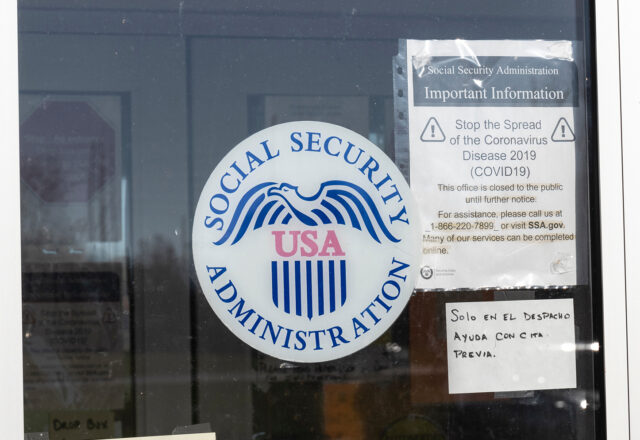
How COVID-19 Spreads in Nursing Homes
The coronavirus has pulled back the curtain on longstanding problems in nursing homes. In 2014, the Inspector General for the U.S. Department of Health and Human Services had reported that more than one in five seniors in skilled nursing facilities experienced “adverse events.” These included poor medical care, patient neglect, and inadequate infection control, which frequently sent residents to the hospital.
Now, some nursing homes have become COVID-19 hotspots. This has contributed to disproportionate numbers of deaths among people over age 70, who may also have weakened immune systems that make them more susceptible to the virus or underlying medical conditions that increase their mortality rate.
Anthony Chicotel, a staff attorney with California Advocates for Nursing Home Reform, discussed what he’s seen in nursing homes in the months since the pandemic began.
Briefly, Tony, name the big three underlying problems you feel caused the virus to spread.
Chicotel: No. 1 is chronic understaffing to meet the needs of the residents and to perform all the basic functions required every day. No. 2 would be a tolerance for poor infection control practices. This flows from No. 1 because good infection control requires time, and it’s one of the things that gets cut when you’re pressed for time. No. 3 might be the practice of staff working in multiple facilities. Because they are often low-paid, it’s not unusual for them to work for two different companies that do nursing home care, or they might also work for an assisted living provider. This cross-pollination contributes to the spread of the virus among facilities. We’ve also learned that most of the staff who had the coronavirus have been asymptomatic.
The problems in nursing homes are not new?
Chicotel: I think we should’ve anticipated this. Coronavirus has brought all this out into the open but the Centers for Disease Control cites a a pre-pandemic study that found that up to 388,000 nursing home residents die each year resulting from poor control of infections such as Methicillin-resistant bacteria (MRSA) and urinary tract and respiratory infections. We’ve just accepted this staggering breakdown of infection control for a long time. I’m an advocate, and it wasn’t something I really focused on either. It’s been begging to be addressed in a significant way for some time.
Talk about infection control. In this pandemic, everyone is aware that hand washing is critical to stopping the virus. You cited a report by the Centers for Medicare and Medicaid Services (CMS) that 36 percent of long-term care facilities do not comply with hand-washing protocols and 25 percent do not comply with protocols for personal protective equipment (PPE).
Chicotel: Those statistics come from what the government calls infection-control focused surveys. CMS performs annual inspections to look at diet, medication distribution and those kinds of things. But they shut these surveys down when the coronavirus hit to focus on infection control. When CMS went into U.S. nursing homes, staff at the facilities knew that the surveyors in the building were looking specifically at infection protocols. It was remarkable to me that the poor results of the survey were under conditions where the facilities were doing their absolute best to comply.
The other thing that’s remarkable was that coronavirus was out and about, and everybody was talking about it so infection control should’ve been at the top of their minds. But if the CMS survey had been in November when no one was talking about the coronavirus, 36 percent non-compliance would’ve been a blip in the news.
What is the specific infection control regulation, and how did the protocols lapse?
Chicotel: The regulation is pretty straightforward. There are three big categories. First is wash your hands between providing personal care to residents. It’s common sense, but some details trip up staff people. For example, even if you’re wearing gloves, you’re required to wash your hands before you put the gloves on and again when you take the gloves off. There’s also a protocol for PPE and for isolating residents with an infection. The guidelines for the infection control regulations are over 40 pages long.
Why aren’t the protocols followed?
Chicotel: One thing is poor training and poor instilling of habitual sanitation practices. And even if the staff knows what the right techniques are, they just get in a hurry. Infection control (IC) protocols are one of the first casualties of being understaffed. Here’s an example I’ve seen multiple times. I have gone to nursing homes to see patients who are in quarantine. When you get to their room, a big sign says this patient has IC protocols. A gown and gloves are taped to the door, and I put them on. Then I’d see staff come in and not put any PPE on and give a medication to the resident or put something down in the room. If you have to go in 20 times a day, staff start saying I don’t want to do this. And they are not going to get immediate feedback if they got something wrong. If your technique of putting someone on the toilet is wrong, a resident breaks a hip, which has serious consequences. But if you have poor IC, the problem takes time to develop and no one remembers how it started.
Some 600,000 nursing assistants are the backbone of long-term care facilities. The typical assistant earns just over $13 per hour. The public frequently hears about the difficulty hiring staffing. How is this an issue in a pandemic?
Chicotel: Because of the physical nature of nursing assistants’ work — repeated turning, lifting and transporting of patients — their likelihood of injury is three times greater than that for the general population. Not surprisingly, staffing shortages and rapid turnover are endemic.
It’s also generally considered a low-quality, low-paid position without a lot of opportunities to be promoted. Nursing homes use a lot of immigrant labor, and a lot of times English is a second language. They’re good people, but it’s a vulnerable, exploitable labor pool. They’re also asked to do a whole lot with not enough time, so there’s no other way to get their job done without cutting corners.
Another problem is that they don’t get sick pay and they can’t sacrifice the pay so they show up for work and try to hide the fact that they’re sick. Life Care Center in Kirkland, Washington had the first huge outbreak, and there were reports that many of the staff working in multiple facilities were coming in when they were sick.
Richard Mollot, executive director of the Long Term Care Community Coalition, wrote recently that federal regulation – the Nursing Home Reform Act of 1987 – is comprehensive but that enforcement is weak. What have advocates like you seen in the field in terms of enforcement?
Richard’s opinion is consensus among nursing home advocates. The federal government created standards that, if they were followed, would be pretty good. But, as I said, we’ve had a tolerance for bad practices. We know historically that infection control was the No. 1 cited deficiency in nursing home inspections before the coronavirus. But when the federal government finds violations, it hasn’t meant much. In 98 percent of these cases, there’s no fine, and all the facility needs to do is say we’re going to have all the staff of the nursing home trained in their monthly meeting they attend. For example, they might be reminded of the handwashing protocol. Enforcement has no teeth.
Mollot said Maryland and Florida are sending strike teams into nursing homes to assess safety. What do these teams do?
In California, these strike teams are state projects, though Congress is considering more funding for them. California has two models. One is that the teams play a consultancy role, and if a facility has an outbreak or wants to avoid one, these teams go through the facility’s policies and procedures, augment them and do demonstrations to resolve problems. We’ve been told that these strike teams have gone into 260 nursing homes in California as of late April – that’s about one out of every five. The other type of strike team actually sends people to work in the facilities, which either are so crippled because of the virus that they need more staff or because staff are positive for the virus or sick and can’t come in. That’s an all-hands-on-deck situation. The problem is the facility has to ask for the additional workers, and the state charges them. So these staffing strike team arrangements have only happened a handful of times in California.
What is the relationship between federal regulation and the regulations in each of the 50 states? And which is more effective?
Chicotel: Even in California, which is a pretty progressive state, the federal regulations are more comprehensive than the state regulations. What’s happened now is the states have filled in what the federal government started. In regards to the virus, I would say most states are still relying on the federal government to do the heavy lifting, though I don’t think that’s entirely true in California and a few other states that have ramped up oversight of practices related to coronavirus.
Are nursing homes in California ever shut down for violations?
Chicotel: Yes, but it’s very rare. In California, maybe one every year or two.
Some research shows that non-profit hospitals provide better quality, particularly when residents do not have family members to oversee care. Do you see a difference in this crisis between how the private and non-profit facilities have responded to the coronavirus?
Someone will eventually go through the outbreaks and find out the COVID-19 case percentages for private versus non-profit. But the pandemic should prompt us to re-examine the model of for-profit long-term care facilities, which account for 70 percent of nursing homes.
COVID-19 has revealed the problems. Will this bring change?
The coronavirus is a major event that should alter the way we do nursing home care. I’ve spent 20 years working on nursing homes, and I don’t want to spend another 20 years getting marginal improvements. I think it’s time to examine the ways we deliver long-term care. My goal is to move the country away from the institutional model of care to more home-based care by loved ones. We’ve moved that way over the past 30 years.
But, a year from now, there might be a lot of complacency and people will say that this was a once-a-century thing. We’ll have to be really committed to not letting that be forgotten.
Read more blog posts in our ongoing coverage of COVID-19.
Squared Away writer Kim Blanton invites you to follow us on Twitter @SquaredAwayBC. To stay current on our blog, please join our free email list. You’ll receive just one email each week – with links to the two new posts for that week – when you sign up here. This blog is supported by the Center for Retirement Research at Boston College.
Comments are closed.







It is unsurprising that when you’re expected to generate profit, infection control might be the first thing you compromise because you might just get away with it.
The real question the politicians will never let you know even under the FOIA act are the following two ratios: the first one being the infection rate for the general population both in NJ and NY; and more importantly the infection rate in nursing homes based upon their nursing home total population. I guarantee the second figure will never come out.
There are many problems in the U.S. with caring for our elderly. The majority of nursing homes are for profit, and the best way to make a profit is to skimp on costs: use low-paid staff, work them too hard and don’t “waste” money on training. With some commendable exceptions, most U.S. nursing homes are warehouses rather than care facilities. We can and must do a better job for our most vulnerable citizens.